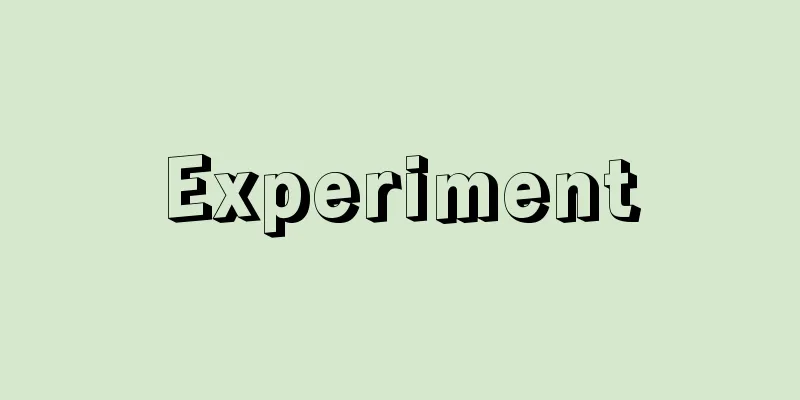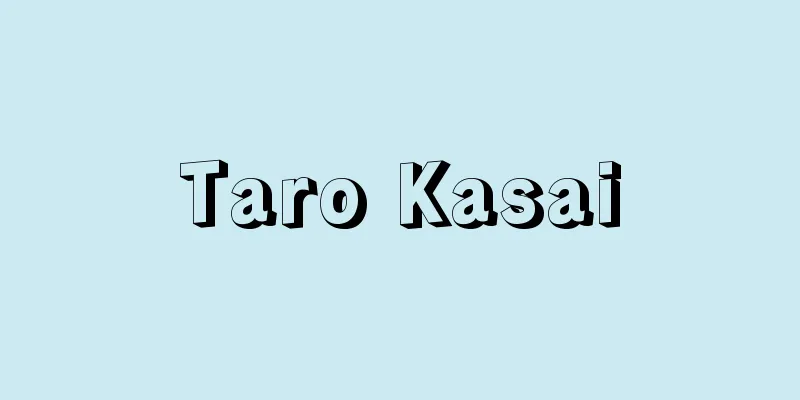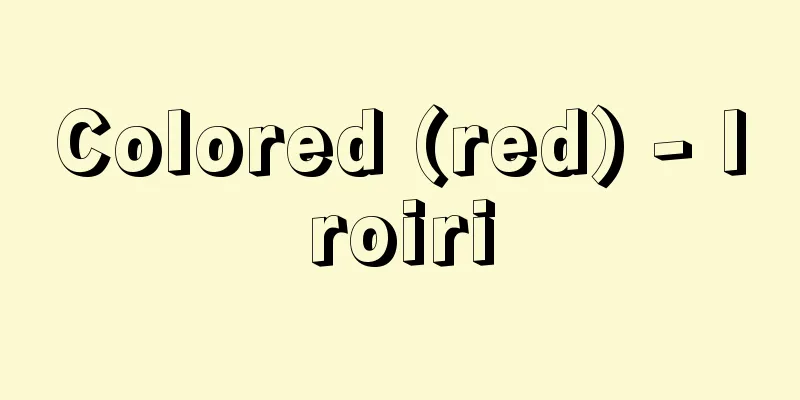Experiment

|
Scientific research activities are theoretical activities that focus on various phenomena and behaviors in nature and society (including humans as part of them) in order to elucidate the mechanisms and laws of motion that make the subject what it is, and to gain a deeper understanding of the subject. As part of this theoretical activity, experiments play a practical role in directly or indirectly influencing the research subject of the science in question, and incorporating the subject into theoretical activity. Therefore, experiments are not merely a narrow means of research or a procedure, but are an essential component of theoretical activity. Data collection activities such as observation, monitoring, measurement, excavation, exploration, and field surveys are also experimental activities, and are not activities unique to the natural sciences, but here we will focus on experiments in the field of natural sciences. Some people think that scientific research activities can be separated into "theory" and "experiment," but this is a mistake that has been made by being distracted by the progress of the professional division of labor between the theoretical and experimental fields. Although "theoretical" activities based on logical thinking and "practical" activities that use means and operations to affect an object may sometimes lean toward one side or the other, the activity of recognizing an object itself is by no means limited to means and operations, and the two are unified. Now, natural science is not simply something that was created by the inspiration and intuition of scientists, but was originally born and developed from productive practice of working with nature. The practical activity of working with nature, which is to objectively recognize nature and verify its truth, is in itself something that is learned and abstracted from productive practical activity, i.e. labor. Therefore, it goes without saying that the subject of labor, the means of labor, and technology as a system thereof have a deep interaction with science. In other words, everything from the material things such as the creation of new research subjects and experimental means to the development of methods of cognition such as methods of research activities, setting of tasks, and comprehensive perspectives are the products of the historical development of society, and the development of rich cognition greatly influences the historical and economic development of society through technology. In this sense, natural science is firmly anchored in nature itself and productive technology through the passage of experiments. It was R. Bacon who first explained the significance of experiments linked to the nature of science. He broke away from the so-called scholasticism and listed "experience," "experiment," and "proof" as the three paths of science. In the famous Opus Majus (1266-1268), part 6 " Scientia Experimentalis ," he argued that "experiment gives theory, and theory is the most important means of leading to new conclusions." At the end of the 15th century, Leonardo da Vinci also observed nature keenly, saying, "We can draw general rules from experience in various cases and under various circumstances," and he also turned his sharp analytical eye to technical problems in the production field. The bottega (workshop) that raised da Vinci was a huge production factory that intensively utilized various technologies such as metal processing, metallurgy, and stonemasonry at the time, and became the source of da Vinci's activities. His line of anatomy, typified by his sharp observations and precise sketches, later bore fruit in Vesalius's Seven Books on the Structure of the Human Body (Fabrica) (1543), and eventually Harvey clarified blood circulation based on measurements of the volume and beat rate of the heart (1628). Thus, modern anatomy and modern physiology, which make up essential components of experiments such as dissection and measurement, were born. On the other hand, a great number of technical books appeared in the 16th century, such as Biringio's Pyrotechnics (1540), Agricola's De re Metallica (1556), Schoppel's Book of Industrial Arts (1568), Ramelli's Various Ingenious Machines (1588), and Veranzio's New Machines (1595). The spread of such technical books clearly demonstrated the new value of the practicality of learning, that is, of combining learning with productive practice. These books overcame the descriptions of natural history, which were full of mystical, magical, and esoteric allegories and symbols, and opened up the possibility of objectively understanding the relationships between concrete things. A new form of production called "manufacture" appeared at the end of the feudal society in the Middle Ages, when Da Vinci was active. Metallurgists, makers of clocks and measuring instruments for navigation, and makers of machines such as water and windmills, consciously recorded empirical rules while repeating trial and error with concrete objects in the process of production. Such actions led to the development of methods and means of natural cognition, including observation, observation, and measurement that actively affect the object, rather than merely contemplative observation. W. Gilbert, who had contact with navigators and metallurgists, also wrote "De Magnete" ("Of the Magnet, Magnetic Bodies, and the Great Magnet of the Earth. A New Physiology Proved by Many Discussions and Experiments", 1600), which was deeply related to the aforementioned situation of the times. He created a small magnetic globe (terra) as a model and succeeded in demonstrating the logical clarity of "a series of experiments and discoveries, carried out and proved at great labor, all-nighters, and expense." This had a great influence on scientists of the time, including Galileo, Kepler, and Descartes. Galileo correctly positioned the significance of the telescope as a means of observation in the new development of astronomy, which was prompted by the development of navigation. He also focused on machines, which were beginning to gain importance, and lectured on "Les Mechaniques," in which he performed numerous experiments (including thought experiments) making full use of the principles of the lever and buoyancy. He incorporated experiments not only on motions constrained by machines, but also on free fall and projectile motions. He broke down the subject of machinery and motion into elements, and in the light of experiments (including thought experiments), he advanced to theoretical understanding, but he again reconstructed and positioned it within the overall process of the machine's function and motion. The compilation of this abstraction of mechanics was his "Dialogues on the New Sciences" (1638). There is a strong belief that Galileo's research is the beginning of the "theory of the elements," but this is a mistaken view that only sees the first part of his research, in which he broke down nature into elements and "tortured" (experimented) nature. He did not forget to conduct a comprehensive evaluation afterwards. It can be said that this misconception arises from a prejudice against experiments that views the newly emerging experimental methods of science as merely manipulations. Galileo's successor Torricelli and others started systematic experiments (the Accademia del Cimento and the Accademia dei Lincei). Meanwhile, F. Bacon's Noum Organum (1620) and New Atlantis (1624), Descartes' Discourse on the Method (1637) and other works were written, which discussed the significance of observation, experience, practical activity, and the integration of various information obtained from these activities, and began to clarify the theoretical understanding of objective objects (nature) and the significance of experiments. Furthermore, systematic experiments were accumulated at the Invisible College in England and the Royal Society thereafter. Based on the development of these activities, Newton's Principia (1687) and Optics (1704) appeared, and the essential role of experiments in science became firmly established. In the 18th century, we saw the improvement of astronomy observational equipment, the development of geodesy on a global scale, and the accumulation of qualitative and quantitative experiments in electrostatics, thermology, gas chemistry, and other fields. In particular, the Industrial Revolution, which began in England, and its impact on other countries, deeply linked natural sciences to technology and posed new challenges to science through experiments. In response to this, in the 19th century, the undifferentiated natural sciences were established as individual sciences, and began to establish their own fields of study and methods, and the establishment of skilled methods specific to each differentiated science became necessary. For example, as can be seen in the founding of Liebig's modern student laboratory in Giessen, experiments themselves also tended to become specialized. In the 20th century, the subject of research expanded dramatically from the macroscopic world on a cosmic scale to microscopic matter such as elementary particles, genetic manipulation, medicine, information science, etc. Furthermore, not only the subject of research but also specific research methods expanded dramatically, such as the need for a comprehensive understanding of global subjects such as the global environment, research on newly created groups of substances such as new materials, and the behavior of materials accompanying the creation of new environments as typified by the phenomenon of superconductivity, and specialization progressed. The development of natural sciences has led to the systematization, automation, and enlargement of the subjects and means (apparatus, equipment, measuring devices, etc.) that constitute experiments, which has come to require specialized theories and a group of skilled researchers and engineers. Furthermore, the system of experimental means has become a commodity, and capital has intervened, spurring the division of labor. An experiment is, as part of theoretical activity, composed of an experimental subject, experimental means, and a researcher that are in line with the objective. Therefore, in line with the objective, the material object and means (their system) must be organized not only in terms of physical consistency, but also as a lever for theoretical cognition. For this purpose, experienced researchers mobilize theories and technologies of the equipment and devices and the system itself, theories and technologies of measuring instruments as an extension of the senses, and a certain system of experimental theories and technologies similar to engineering for coordinating the linking of various groups of materials. This allows the researcher to control the conditions of nature in various ways and come close to understanding the various forms of motion of the object. Today, advanced computers have made it possible to simulate complex forms of movement, and we are pioneering a unique field of "thought experiments." Science is about directly interacting with nature through experiments, but it is important to keep in mind that the research subject and method interact with the production technologies of the time, and in many cases, they are subject to historical constraints. [Satoshi Ihara] [References] | |Source: Shogakukan Encyclopedia Nipponica About Encyclopedia Nipponica Information | Legend |
|
科学研究活動は、自然および社会(その一員としての人間を含む)の諸現象・諸行動を対象とし、対象を対象たらしめている仕組みや運動の法則性を解明し、対象をより深く認識する理論的活動である。実験はこの理論的活動の一環として、当該科学が対象とする研究対象に直接・間接に働きかけ、対象を理論的活動のなかに取り込んでくる実践的役割を担う。したがって、実験は、本来、単なる研究の手段や操作という狭いものではなく、理論的活動の不可欠の構成部分をなす。観察・観測・計測や発掘・探査・フィールド調査などデータ収集活動も実験的活動であり、自然科学のみに特有な活動ではないが、ここでは自然科学分野の実験について扱う。 科学研究活動は「理論」と「実験」とに分離できるものとする考え方もあるが、これは理論分野と実験分野の職業的分業の進展に目を奪われた錯誤である。論理的思考による「理論」的活動と手段や操作をもって対象に働きかける「実践」的活動が、ときによってどちらか一方に偏ることもあるが、対象を認識する活動そのものは、けっして手段や操作にとどまるものではなく、両者は統一されているものである。 さて、自然科学は単に科学者の頭脳のひらめきや直感のみでつくりあげられたものではなく、元来、自然に働きかける生産的実践を源泉として生まれ、発展してきた。自然を客観的に認識し、その真理性を検証するという自然に対する実践活動そのものは、そもそも生産的実践活動=労働から学び取られ、抽象されたものである。したがって、労働対象や労働手段またはその体系としての技術が、科学と深い相互作用を行うことはいうまでもない。つまり、新たな研究対象や実験手段の創造という物質的なものから、研究活動の方法や課題の設定、総合的視野など認識方法の発展までが、社会の歴史的発展の産物であり、豊かな認識の発展は技術を介して社会の歴史的・経済的発展に大きく影響を与える。この意味で自然科学は実験という通路を通して、しっかりと自然そのものと生産的技術に錨(いかり)を降ろしている。 科学のこうした性格に連なる実験の意義を初めて説いたのはR・ベーコンである。彼はいわゆるスコラ学と決別し、科学の三つの道として「経験」「実験」「証明」をあげた。有名な『大著作』Opus Majus(1266~1268)の第6部「経験の学」Scientia Experimentalisでは、「実験は理論を与え、理論は新しい帰結に導くもっとも重要な手段である」と説いた。また、15世紀末にレオナルド・ダ・ビンチは「吾人(ごじん)は種々の場合や種々の状況のもとで経験に相談しつつ、そこから一般的規則を引き出すことができる」として、自然を鋭く観察するとともに、生産現場での技術的課題にも鋭い分析の目を向けた。ダ・ビンチを育てたボッテーガbottega(工房)は、当時、金属加工、冶金(やきん)術、石工技術をはじめとする諸技術を集約的に駆使する一大生産工場であり、ダ・ビンチの活動の源泉となった。鋭い観察と精妙なスケッチに代表される彼の解剖学の流れは、その後ベサリウスの『人体の構造に関する七つの本(ファブリカ)』(1543)となって結実し、やがて心臓の容積と拍動数の測定を基礎にハーベーが血液循環を明らかにする(1628)。かくして解剖や測定という実験を不可欠な構成要素とする近代解剖学や近代生理学が登場してくる。 一方、16世紀におびただしい技術書が現れる。ビリングチオの『火工術』(1540)、アグリコラの『デ・レ・メタリカ』(1556)、ショッペル『工芸書』(1568)、ラメリ『種々の精巧な機械』(1588)、ベランツィオ『新機械』(1595)などである。こうした技術書の普及は学問を生産的実践との結合でとらえるという、いわば学問の実践性という新しい価値を明確な形で示した。これらは、神秘的、呪術(じゅじゅつ)的、秘教的な寓意(ぐうい)や象徴に満ちていた自然誌の記述を克服し、具体的な事物のかかわりを客観的にとらえる可能性を切り拓(ひら)いたものといえる。 マニュファクチュアという新たな生産形態がダ・ビンチの活躍した中世封建社会の末期に現れ、冶金術者、時計・航海用測定器械製作者、水車・風車をはじめとする機械製作者らは、その生産の過程で具体的事物を相手に試行錯誤を繰り返しつつ、経験的規則を意識的に記録した。こうした行為は、単なる観照的な観察から、対象に能動的に働きかける観測、観察、測定を含む自然認識の方法と手段を発展させることとなった。航海者や冶金職人らとの交流を行ったW・ギルバートが『磁石について』(「磁石、磁性体および大きな磁石である地球について。多くの議論と実験によって証明された新しい生理学」、1600)を著したのも前述の時代状況と深くかかわっていた。彼は磁石の小地球(テレラ)をつくってモデル化し、「多くの労力と徹夜と費用をかけて実行し証拠づけた一連の実験と発見」の論理的明晰(めいせき)性を示すことに成功した。これはガリレイ、ケプラー、デカルトら当時の科学者に大きな影響を与えた。 ガリレイは航海術の発達に促された天文学の新たな展開に、観測手段としての望遠鏡の意義を正しく位置づけた。また重要度を増し始めた機械に注目し、『レ・メカニケ』を講義し、てこの原理や浮力の原理を駆使しつつ、おびただしい実験(思考実験を含む)を行った。機械に束縛された運動ばかりでなく、自由落下や放物体の運動にも実験を取り入れた。対象たる機械や運動を要素に分解し、実験(思考実験を含む)に照らし理論的認識へと進むが、ふたたび機械の機能や運動の全過程のなかでそれを再構成して位置づける。かくして抽象された力学の総集編が『新科学対話』(1638)であった。ガリレイの研究を「要素論」の始まりとする考え方が根強くあるが、これは、自然を要素に分解し、自然に「拷問をかける」(実験する)彼の研究の前段部分しかみない誤った見方である。彼はその後に総合的評価を忘れてはいないのである。新しく登場した科学の実験的方法を単に操作としてしかみない実験への偏見から誤った見方が生み出されているといえる。 さて、ガリレイの後継者トリチェリらによって組織的実験(アカデミア・デル・チメント、アカデミア・デイ・リンチェイによる実験的活動)が開始される。一方で、F・ベーコンの『ノウム・オルガヌム』(1620)、『ニュー・アトランティス』(1624)、デカルトの『方法序説』(1637)などが著され、観察、経験、実践的活動とこれから得られる種々な情報の集約の意義が論じられ、客観的対象(自然)の理論的認識と実験の意義が明らかにされ始める。さらに、イギリスにおける「見えざる大学」Invisible Collegeとその後の王立協会における系統的な実験の蓄積が行われ、こうした諸活動の発展のうえに、ニュートンの『プリンキピア』(1687)、『光学』(1704)が現れ、科学における実験の本質的な役割が不動のものとなった。 18世紀に入ると、天文学における観測機器の向上、地球規模での測地学の発展をはじめ、静電気、熱学、気体化学などにおける定性的および定量的実験の蓄積をみる。とくにイギリスに始まる産業革命とその各国への影響は、自然科学を技術に深く関係づけるとともに、実験を通して新たな課題を科学に投げかけるものとなった。これを受けて19世紀には、未分化であった自然諸科学が個別の科学として成立し、固有の対象領域と方法を確立し始め、分化した科学に固有な熟練した方法の確立が求められるようになる。たとえばギーセンにおけるリービヒの近代的な学生実験室の創設にみられるように、実験そのものも専門分化の傾向をたどる。 20世紀に入って、研究対象は宇宙的規模のマクロな世界から素粒子のようなミクロな物質や遺伝子操作、医学、情報科学分野などその領域を飛躍的に拡大した。また、地球環境のようなグローバルな対象の総合的認識の必要性や新素材など新たに創製された物質群の研究、超伝導現象に代表される新たな環境の創製に伴う物質の挙動など研究対象のみならず固有の研究方法も飛躍的に拡大し、専門分化が進行した。 こうした自然科学の進展が、実験を構成する対象、手段(装置、機器、測定機器など)のシステム化、自動化、巨大化を引き起こし、それに専門の理論と熟練した研究者・技術者集団を必要とするようになった。また実験手段の体系が商品となり資本が介入し、分業化に拍車がかけられたといえる。 実験は、そもそも理論的活動の一環としてその目的に沿った実験対象と実験手段と研究者によって構成される。したがって目的に沿って、物質的な対象と手段(その体系)が物質的な整合性ばかりでなく、理論的認識のてことして組織されなければならない。そのために機器・装置やその体系そのものの理論と技術、感覚の延長としての測定機器の理論と技術、各種物質群を整合的に連動させるための工学に似た一定の実験理論と技術の体系が、熟練した研究者によって動員される。このことによって研究者は自然の条件をさまざまにコントロールし、対象の運動諸形態の認識に迫りうるのである。 今日では、発達したコンピュータによる複雑な運動諸形態のシミュレーションが可能となり、独自な「思考実験」分野を開拓しつつある。科学は実験を通して自然と直接交渉するものであるが、研究対象と手段はその時代の生産諸技術と相互作用し、多くはその歴史的制約を免れないことにも留意しておく必要がある。 [井原 聰] [参照項目] | |出典 小学館 日本大百科全書(ニッポニカ)日本大百科全書(ニッポニカ)について 情報 | 凡例 |
<<: Introduction to Experimental Medicine
Recommend
Sound mode - Onkyo mode
…The optical mode has a frequency of approximatel...
Siwa (language) (English spelling) Siwa
...(see Africa, [Languages]) is a subgroup found ...
Figured glass - Kataitagarasu (English spelling)
This is glass with an uneven surface, and is made...
psychic determinism
...From Freud to the present day, as the range of...
Kawagoi - Kawagoi
A type of carp that is cultivated, this is the Ka...
Daijoin Temple
The most famous monzeki (head priest) of Kofuku-j...
Siberian Intervention
The war of intervention against the Russian Revol...
Christian Freedom - Kirisutosya no Jiyu (English spelling) Von der Freiheit eines Christenmenschen
This is the most excellent short work by the Germ...
King, William Lyon Mackenzie
Born December 17, 1874 in Berlin, Ontario [Died] J...
Vāgbhaṭa (English spelling)
A 7th-century Indian physician. Dates of birth and...
Apple brandy
A distilled alcoholic drink made by fermenting ap...
Brummtopf
…In some regions, instead of a stick, horsehair o...
Pneumomediastinum - Pneumomediastinum
… [Mediastinal emphysema] An abnormal accumulatio...
Mibu Kyogen
Nembutsu Kyogen is a form of kyogen performed at ...
Manizales (English spelling)
The capital of Caldas State in central-western Col...









